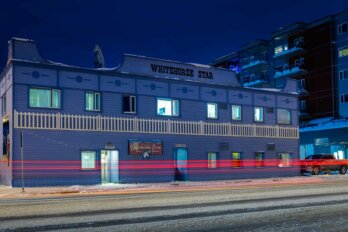Resignation and outrage colour veteran journalist Mary-Ann Barr’s voice as she reflects on the Red Deer Advocate and its coverage of the recent Alberta provincial election. “There was a brief in the paper yesterday about who the candidates are—buried on page four,” says the former editor and reporter who spent thirty-one years at what is now Red Deer’s last remaining local newspaper. Black Press Media, which owns almost a 100 papers in western Canada, announced last month it could no longer afford two competing titles in the same city and shut down the weekly Red Deer Express.
“When I started reporting, the Red Deer Advocate was many, many pages—there were ninety-plus pages in some editions,” Barr said in a telephone interview. Red Deer—which also lost its television station in 2009—is among the nearly 200 Canadian communities where, over the past decade, one or more local news outlets have closed. With layoffs gutting many other newsrooms, the symptoms of local news poverty are increasingly evident: the underreporting of complex political issues, the proliferation of superficial journalism, and a citizenry deprived of credible information. “It wasn’t long ago that we would have a reporter and photographer do a ride around in the five or six ridings we covered in central Alberta,” Barr reminisced. “They would talk to voters and get an idea of what the heck was going on. We’d run a map, we’d have photos. It was great coverage.”
When it comes to Red Deer, such election coverage is history. Barr, who retired in mid-2017, said in an email that as recently as 2012 there were twenty-four full- and part-time editors, reporters, and photographers in the newsroom. At the time of the 2015 federal election, the newsroom complement was fifteen. Today, with the next federal vote six months away, Barr says there are nine reporters left. The daily, now published in a smaller tabloid format, not only covers fewer electoral districts but has replaced probing analysis with short pieces based on press releases. Barr notes that Advocate reporters are often scrambling to comply with company missives that require them to generate a minimum of two stories, plus news briefs, photos, and the occasional video, on every shift. “Given what any reporter has to produce in a day, the idea of in-depth, thoughtful journalism is disappearing,” she said.
Red Deer, a city of about 100,000, isn’t the only place in the country where the crisis in local journalism is reshaping political coverage in advance of the October 21 federal election. “Newspapers, even smaller newspapers, used to have two or three people covering politics,” says Martin O’Hanlon, the president of CWA Canada, which represents journalists in newsrooms across the country. “Now you are lucky if you have one person covering all levels of politics, not just city hall,” he says. When local reporting is eroded to such an extent, how do you hold politicians to account? “It’s not the fault of the journalists—they want to do a good job,” says O’Hanlon. “But, in many places, coverage has become a joke.”
Alarm over the situation has spread outside of newsrooms. Brian Saunderson, the current mayor of Collingwood, Ontario, recently suggested that greater media scrutiny might have prevented the resort town, located northwest of Toronto, from becoming embroiled in a controversy involving, among other issues, over $1 million in consultancy fees paid to the previous mayor’s brother, a former Liberal MP. “There were very few reporters working at the time to shine the light on the operations at city hall,” Saunderson said as a judicial inquiry got underway. Saunderson said the local Rogers community television station has scaled back its Collingwood operations over the years and that there were few reporters left at the Enterprise-Bulletin, one of two local weekly newspapers, when it closed in 2017. A new digital startup, he said, covers daily news, but “typically, the investigative stories are the exception, not the norm.”
None of this bodes well for citizens who want to cast an informed ballot this fall. We tend to think of party leaders and their national campaigns as the key determinants of election outcomes. One recent study, however, estimated that as many as 10 percent of ridings were decided in 2015 by voters who considered local candidates a decisive factor in their choice. In a healthy media ecosystem, journalists from a variety of news sources will press local candidates for their views on key local and national issues, scrutinize their campaign performances, and evaluate incumbents’ records. They will write stories explaining how national campaign announcements by party leaders affect local residents. When those party leaders come through town, local reporters will push them for answers on community concerns about everything from health care and the environment to immigration and jobs.
Today, many overwhelmed, understaffed newsrooms are often reduced to repurposing press releases and grabbing quotes from politicians’ social-media posts. As Canada’s forty-third general election approaches, the decline in local political reporting—and the possible loss of its role as a civic watchdog—will come with steep political costs.
To better understand how the crisis in local journalism affects political reporting, researchers at Ryerson University’s Local News Research Project (LNRP)—a group that I helped found in 2008—monitored local coverage of the 2015 election in eight communities. The study demonstrated that a voter’s access to news can vary, often dramatically, according to where they live.
Voters in Brampton, Ontario, were most poorly served, and they seemed to know it: 70 percent of respondents to an LNRP survey said local media provided none or not much of the news they needed to cast an informed vote in 2015. The reasons for this became clear when researchers analyzed coverage of the local campaigns in three of the five ridings that make up the sprawling suburban city west of Toronto. During the month before the election, local news outlets produced only two stories per 10,000 registered voters, or forty-three items in total. The vast majority of those stories appeared in just one place: the Brampton Guardian, a Metroland Media–owned community newspaper.
Voters in British Columbia’s Nanaimo area fared better. According to the LNRP survey, local media produced 103 stories (fifteen per 10,000 registered voters) about the local race for MP prior to the vote in 2015. Just a few months after the election, however, Black Press shut down the Nanaimo Daily News, the daily newspaper that generated about half of the riding’s election coverage. Looking back, Sheila Malcolmson, who won Nanaimo-Ladysmith for the NDP in 2015, says she was struck even then “by how shallow the media coverage was. Honestly, the stories were more than anything about vandalizing signs and about public opinion polls. Meanwhile, oil tankers and democratic reform were really big issues, and I got virtually no coverage and no questions about that.”
Malcolmson, who quit as MP to run in a recent by-election and win a seat in British Columbia’s legislative assembly, said she realized when she was in Ottawa that reporters in her riding had little or no time to explore issues in more depth. Her staff, therefore, began adding comments from Nanaimo politicians and other local officials to Malcolmson’s press releases—in effect, doing the work of journalists. “It isn’t ideal, but at least it was a useful way for me being able to communicate what was happening in Ottawa,” she said. During the by-election earlier this year, Malcolmson added, the limited capacity of local media and the unreliability of social media as a community barometer meant she relied heavily on door-to-door campaigning to find out what voters really cared about.
But anemic local journalism also means voters have access to less and less ground-level reporting to help them evaluate canvassing politicians. Over the past four years, 106 local online news sites, newspapers, and radio and television stations have closed in eighty-six Canadian communities, according to data from the LNRP’s crowd-sourced Local News Map. Longer-term data paint an even grimmer picture: since 2008, 275 local news outlets—most of them community newspapers—have closed in 197 communities. Over the same period, only 105 have launched.
“It’s an unfortunate trend,” says Troy Gillard, the news director for rdnewsnow.com, an online news site that launched in Red Deer in mid-2016. Gillard, who is part of a four-person news team that feeds the RdnewsNow website and supplies stories to two local FM radio stations, said newsrooms have scaled back or disappeared even as Red Deer, Alberta’s third-largest city, continues to grow. Running a small newsroom, explains Gillard, means making tough choices about what to prioritize. “We do our best to draw connections to big national stories, but it’s not easy,” he said. “I would love to have an extra couple of bodies, to give them a little more time do more in-depth stories rather than just write three or four quick lines of copy.”
As the death toll for local news outlets rises, waves of layoffs ravage the local newsrooms left standing. The union representing The Ottawa Citizen, for example, had 190 newsroom staff, including reporters, editors, and photographers, in the early 1990s, according to data provided by CWA Canada. That number fell to sixty-five unionized newsroom staff in 2016, a year after the last federal election. As of this month, there are fifty. The Montreal Gazette’s numbers are even more startling. Its union was 275 strong in 1990. Today the newsroom is a forty-one-person operation. CWA Canada membership numbers show the Regina Leader-Post’s unionized editorial staff has dropped to twenty-two from roughly a hundred. The storied Kingston Whig-Standard now has a newsroom of eight. In 1990, its union represented fifty-five members. In its heyday, the paper won multiple national newspaper awards and two coveted Michener Awards for public service in journalism. Its first Michener was for an investigation into fluoride poisoning on a reserve on Cornwall Island; the second was for a twenty-one-part series about federal tax reform. Among the more notable stories by the Whig-Standard include a 1989 exposé of how Canada’s penal system failed an inmate died by suicide in Kingston’s penitentiary for women. Such high-value journalism—which required weeks, if not months of reporting—will be much more difficult to accomplish in a newsroom where staff has been reduced to the single digits.
Smaller newspapers have suffered similar fates. Nearly 60 percent of respondents in a soon-to-be-released LNRP survey on conditions at small-market newspapers in Canada said there were fewer journalists in their newsrooms compared to two years earlier. Penelope Abernathy, a University of North Carolina scholar who has been researching news deserts in the United States, recently coined the term “ghost newspaper” to describe publications where pared-to-the-bone newsrooms cannot adequately cover their communities. Comments from respondents in the LNRP survey are eerily apropos: “I personally write copy for a 32-page paper on a weekly basis, usually writing 15–20 stories a week,” one survey respondent told the researchers from the LNRP and the National NewsMedia Council, a non-profit organization that promotes editorial standards and news literacy. “Because of the time constraints,” the respondent wrote, “community journalists have very little time to do more in-depth reporting that could be more important and relevant to residents.”
Conservative MP Kevin Waugh recently experienced first hand another consequence of newsroom consolidations and cost cutting: the centralization of coverage by newspaper chains and loss of distinct local perspectives on stories. Waugh, who represents the riding of Saskatoon-Grasswood, said when he contacted the Saskatoon StarPhoenix to comment on this year’s federal budget, his offer was forwarded to a reporter at the Regina Leader-Post. Instead of a made-in-Saskatoon story for Saskatoon readers that focused on local responses to the budget, the Leader-Post’s article appeared on the websites of both Postmedia-owned papers: “The duplicate content,” Waugh says, “is more than I have ever seen in the last forty years.”
Waugh said he will get his message out to voters in Saskatoon-Grasswood this fall by spending more to distribute flyers via direct mail. In the meantime, he is drawing on his experience as a former television sports broadcaster to produce short videos that feature his take on everything from the federal budget to organ donation. He posts them on his Facebook page.
Waugh isn’t unique in his use of social media to speak directly to constituents. Ontario’s Progressive Conservative government now has a video channel, misleadingly called Ontario News Now, that chronicles the achievements of the Ford administration. What looks and sounds like news, however, has nothing whatsoever to do with traditional news. It is not produced by an independent source, the information is highly promotional, and there’s no attempt to include diverse viewpoints. As the federal election season gets underway in earnest, some voters will be able to distinguish between journalism and the self-serving material put out by candidates and parties. Others won’t.
It comes as no surprise to Alex Marland that politicians are increasingly using social media to deliver direct appeals to voters. The Memorial University professor interviewed 125 federal and provincial politicians and political staff over the past year about how they manage their political messaging. Based on what he heard, he predicts that getting frank answers from candidates is only going to get more difficult for local journalists. “All politicians, all political staff are concerned that something that is said is going to go viral, that there’s going to be this sense of ‘gotcha’ journalism, that there’s going to be an online pile on, that they are going to get in trouble. So they see safety in sticking to core brands and messaging,” says Marland, who has written extensively about political communication in Canada.
The desire to avoid a social-media firestorm, he said, means politicians are increasingly sticking to the script being given by their parties. This minimizes the potential for independent thinking and career-ending gaffes. An added advantage is that it makes it easy for journalists rushing to meet deadlines and move to the next assignment to just raid a standardized social-media posts when they need comment on an issue. It’s a win-win scenario for the party in that the story parrots carefully crafted political messaging and its politicians can avoid interviews where they might be pressed for clarity and additional information.
The benefits for voters are less obvious. They get no sense of how their local candidates differentiate themselves from their party, if at all. And Marland predicts that the endless repetition of canned political rhetoric will fuel support for plain-speaking populists: “It drives everyone crazy because populist politicians are changing the norms of engagement because they aren’t scripted,” he says. It’s also the case, he adds, that a politician who appears unscripted often “really appeals to people.”
Norman Ragetlie’s concern about local-news poverty going into the fall election is more straightforward. Ragetlie, the executive director of the Rural Ontario Institute, lamented “the change in our civic discourse because of the disappearance of local journalistic capacity.” The non-profit institute he leads produces fact sheets and reports that address challenges facing rural and northern Ontario and issues press releases that highlight the key findings. But, nowadays, Ragetlie says, even topical reports on the loss of rural manufacturing jobs, unequal access to long-term-care beds, and rural labour shortages aren’t enough to spark many calls from journalists.
The lack of accountability, Ragetlie believes, will end up hurting the public. “One of our roles is to stimulate dialogue about issues. Dialogue implies having multiple points of view and perspectives, and when you don’t have that, it’s an issue. There’s a concern that without a platform that is more independent and objective, that the information people are getting doesn’t lead to solutions-based discussions.”
Ragetlie’s concerns prompted him to approach a major charitable foundation earlier this month to explore initiatives to support local journalism. Community foundations are mulling how to get involved. There are local-news entrepreneurs who are experimenting with different funding models. And the federal government has announced a suite of controversial tax measures based, it said in last fall’s economic statement, on the premise that “strong and independent journalism serves the public good.”
What took years to erode, however, is not going to be fixed by October 21.





